FLEXIBLE – RIGID LED MODULES FOR LAMPS FOR HOUSEHOLD APPLICATIONS
STAGES OF DEVELOPMENT
- 2012 – R&D “Development and creation of multi-element frameless LED modules with a power of 5-10 W for LED lamps with an E27 base”.
- 2013 – R&D “Organization of the production of a wide range of multi-element LED modules using COB (chip-on-board) technology, followed by the application of phosphors of various compositions for use in the production of energy-saving lighting equipment.”
- 2013 – R&D “Development of technology for automated mounting of LEDs on printed circuit boards without the use of high-temperature multi-zone furnaces.”
- 2013 – НДР “Manufacture of multi-element LED modules based on COB technology with applied phosphor”.
- 2015 – R&D “Development of high-efficiency high-power volumetric LED modules for household lighting lamps”.
- 2016 – R&D “Manufacture of prototypes and pilot batches of high-efficiency volumetric high-power LED modules for household lighting lamps”.
PATENTS FOR INVENTIONS AND UTILITY MODELS
| Date of registration | Inventors: | |
| Patent of Ukraine for utility model №. 94999 “Multi-chip LED module”. | 10.12.2014 | Nikitskiy G.I., Borshchov V.M., Listratenko O.M., Tymchuk I.T., Protsenko M.A., and etc. |
| Patent of Ukraine for the invention №. 111099 “Multi-chip LED module”. | 25.03.2016 | Borshchov V.M., Listratenko O.M., Nikitskiy G.I., Tymchuk I.T., Protsenko M.A., and etc. |
| Patent of Ukraine for utility model №. 108776 “Lamp with a volumetric LED module”. | 25.07.2016 | Nikitskiy G.I., Borshchov V.M., Listratenko O.M., Sorokin V.M. Tymchuk I.T., Protsenko M.A., and etc. |
| Patent of Ukraine for the invention №. 116261 “Lamp with a volumetric LED module”. | 26.02.2018 | Nikitskiy G.I., Borshchov V.M., Listratenko O.M., Sorokin V.M., Tymchuk I.T., Protsenko M.A., and etc. |
| Patent of Ukraine for a utility model №. 121797 “Powerful lamp with a volumetric LED module”. | 11.12.2017 | Nikitskiy G.I., Borshchov V.M., Listratenko O.M., Sorokin V.M., Tymchuk I.T., Protsenko M.A., and etc. |
| Patent of Ukraine for the invention №. 120107 “Powerful lamp with a volumetric LED module”. | 10.10.2019 | Nikitskiy G.I., Borshchov V.M., Listratenko O.M., Sorokin V.M., Tymchuk I.T., Protsenko M.A., and etc. |
LED MODULES
DESCRIPTION OF CAPABILITIES (AVAILABLE SERVICES)
LLC “RPE “LTU” has developed innovative technical solutions for compact volumetric modules, which made it possible to comprehensively and quite simply improve energy and light efficiency, as well as increase the angle of dispersion of the light flux up to 270 degrees in retrofit lamps with power from 10 W to 15 W and more in flasks with standard sizes A60 and A95.
High-efficiency SMD and COB LEDs manufactured by CREE Inc. (USA) were chosen as LED light sources., as well as widely used high-performance commercial SMD LEDs from LG Innotek Co Ltd (Korea). In LED module emitters, serial LEDs of the latest generations were used, which have increased luminous fluxes and luminous efficiency.
Essence of proposed technical solutions is explained in more detail by specific examples of their implementation. Photos below are show manufacturing sequences of various types of LED modules with a power of 10W and 15W on SMD, mini COB and COB LEDs, the appearance of the modules, their composition and layout.
On fig. 1 shows the sequence of operations for assembling an experimental sample of a volumetric LED module with a power of 10W on SMD LEDs with a power of up to 0.5W.
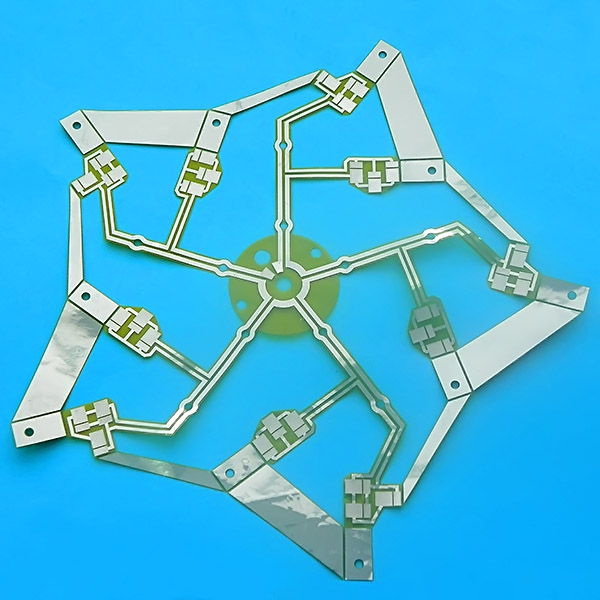
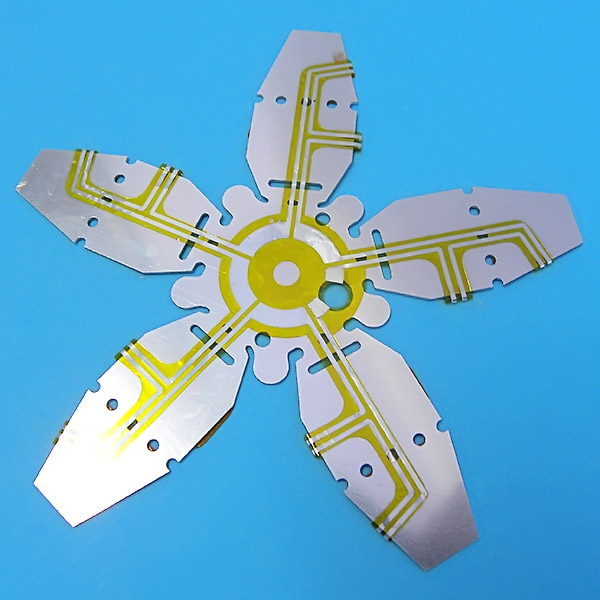
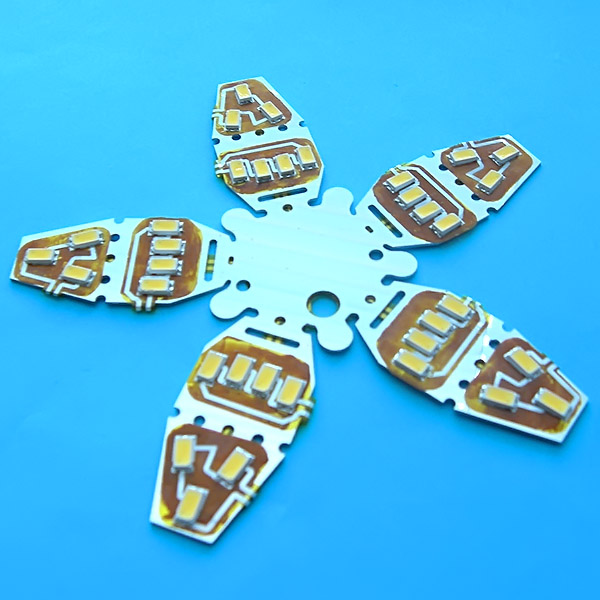
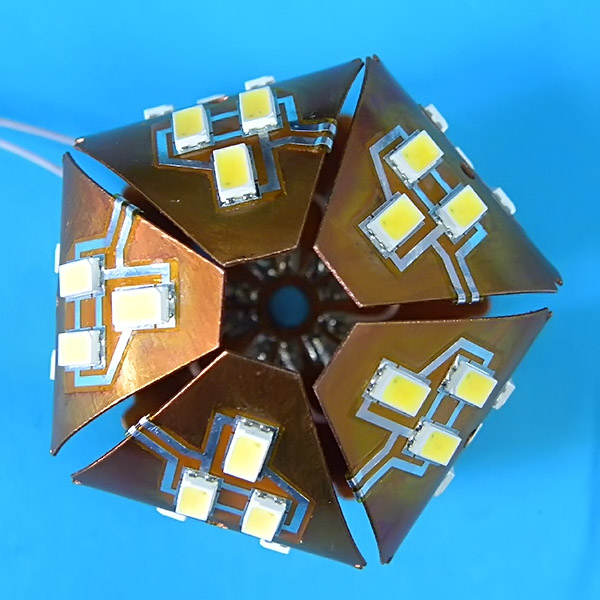
Figure 1 – A sample of a 10 W mirrored volumetric LED module, its composition, layout and assembly sequence:
On fig. 2 shows sequence of operations for assembling a prototype of a 15 W volumetric LED module on MSOW LEDs with a power of up to 1.5 W.
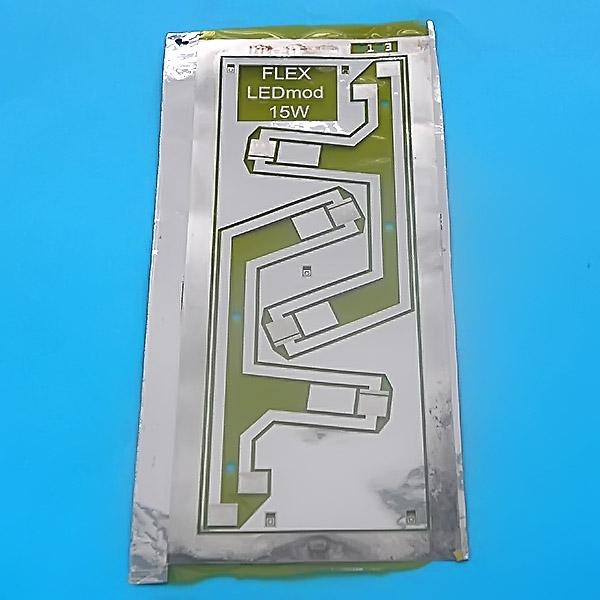
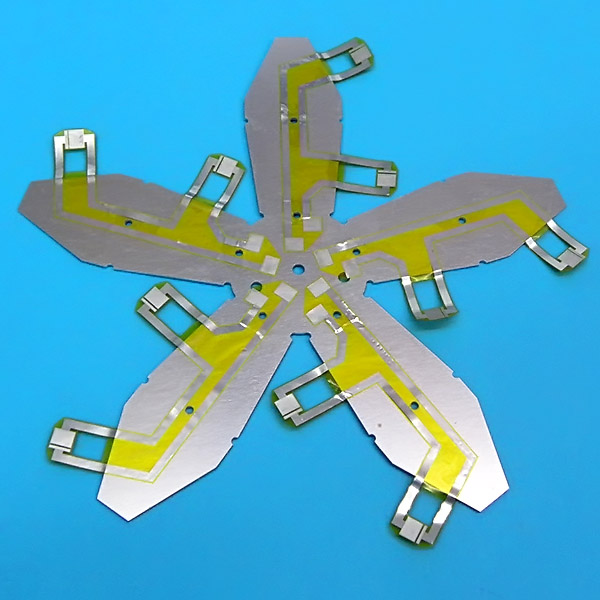
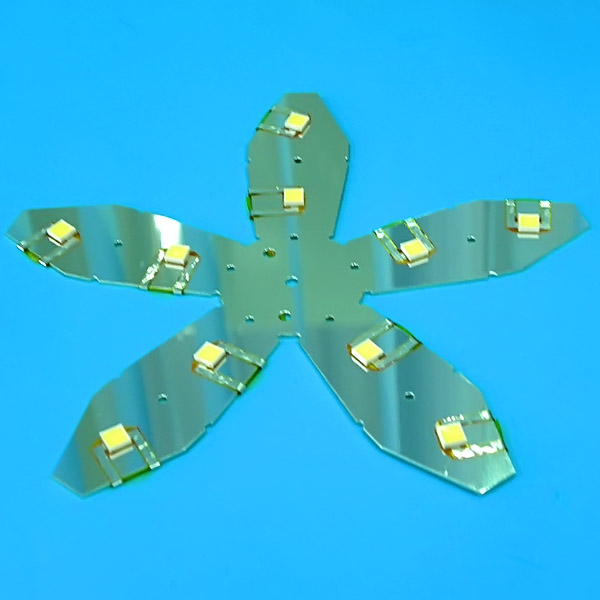
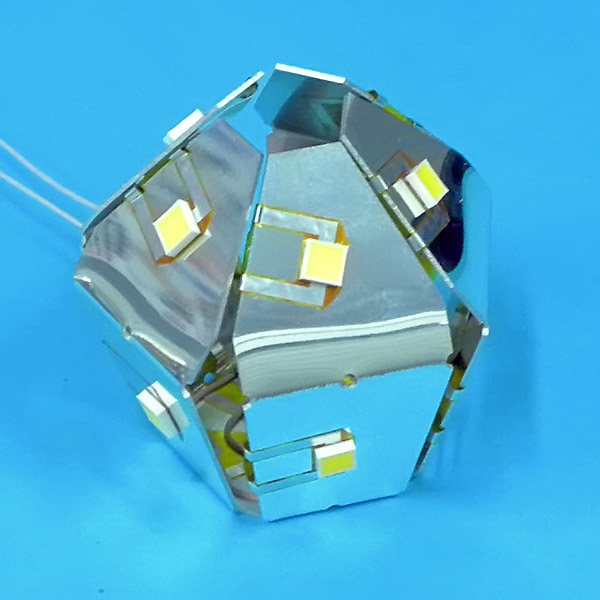
Figure 2 – A sample of a 15 W mirrored volumetric LED module, its composition, layout and assembly sequence:
On fig. 3 shows sequence of forming a three-dimensional LED module from a flat LED module on flexible-rigid mirrored board.
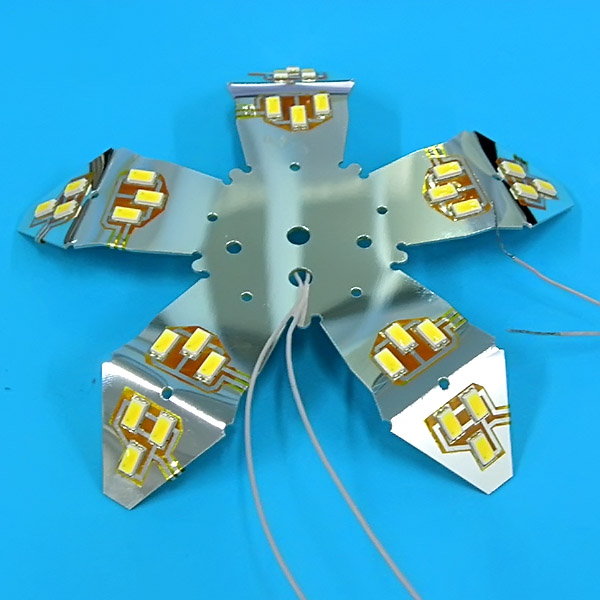
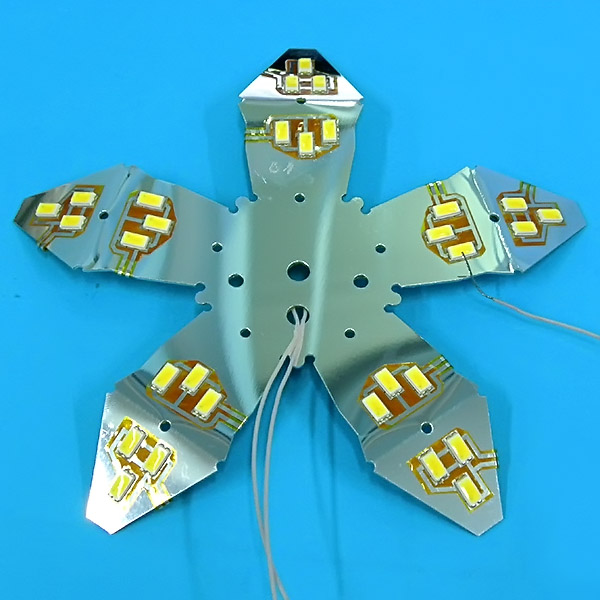
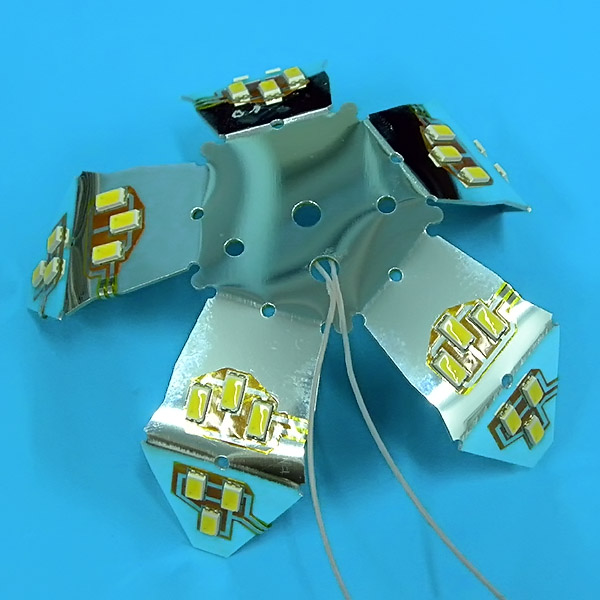
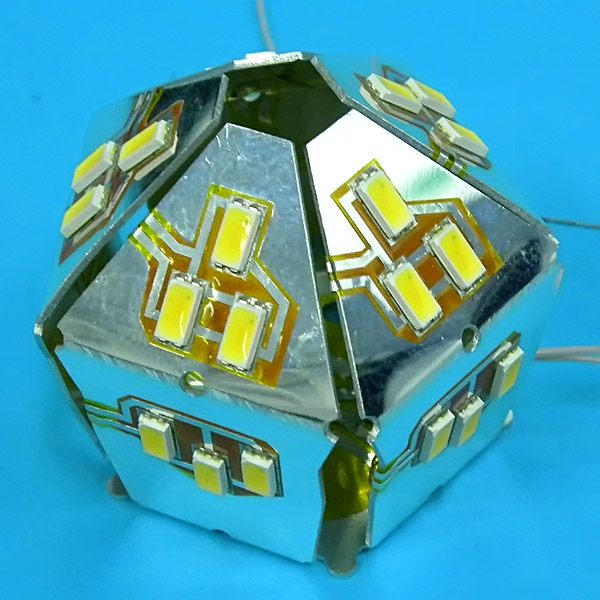
Figure 3 – The sequence of formation of a volumetric LED module from flat LED module on flexible-rigid mirrored board.
Assembly technology developed by LLC “LTU” made it possible to improve the thermal and optical parameters of LED modules for new prototypes of domestic heavy-duty lamps with E27-E40 socles. Including lamps operating in the power range from 15 W to 40 W or more in flasks with sizes A95 and A105 and larger.
Positive technical result was achieved by increasing the area of holders – heat sinks for heat removal by conduction (more than 2.5 – 3 times compared to flat-type LED module with a flat radiator diameter of 80 mm) and additional thermal radiation by the front surface of the volumetric heat sink supports on the inner surface of the diffusing bulb of the lamp. And also by increasing the luminous efficiency of the LED lamp due to the additional re-reflection of light radiation by mirrored reflectors-radiators.
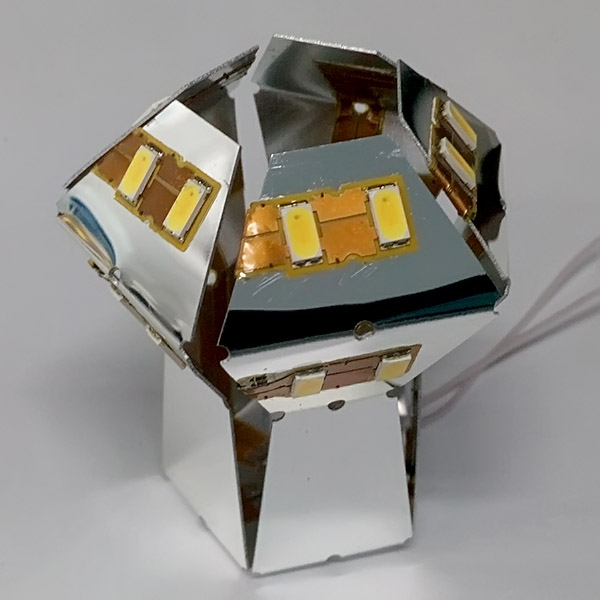
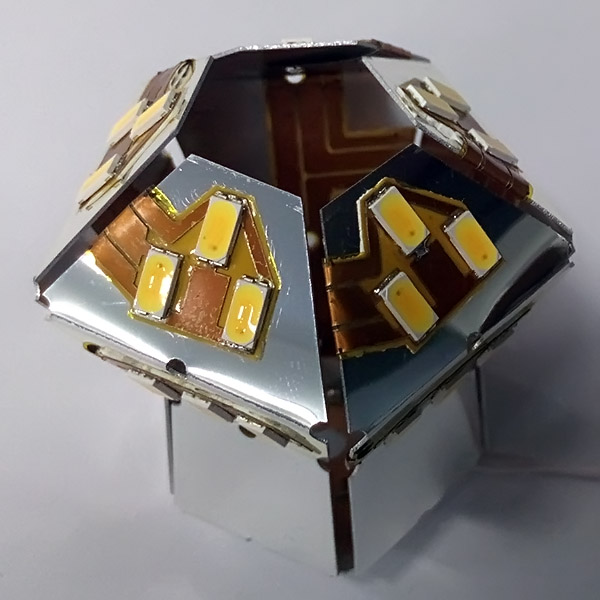
Figure 4 shows samples of advanced high-power volumetric LED modules.
An improved design of volumetric LED modules made it possible to increase the luminous flux in experimental lamps with a power of 15 W – 20 W to 2069 – 2448 lm with a light output of 146 – 124 lm / W. In this case, the maximum temperature of the LED module in the operating mode did not exceed 65°C in the A95 flask.
In turn, in lamps with a power of 30 W – 40 W, the luminous flux was increased to 3572 – 4696 lm with a light output of 119 – 116 lm / W. In this case, the maximum temperature of the SDM did not exceed 65°C in the A105 flask in the operating mode. Also, the angle of light dispersion of lamps with bulb A95 and A105 was increased to 290 degrees.
PUBLICATIONS
| Article title | |
| 2011 | |
| 1 | Borshchov V., Domestic multichip high-powerful led modules for the lighting systems/ V. Borshchov, O. Listratenko, V. Antonova, Ya. Kostyshyn, I. Tymchuk, M. Protsenko, M. Kolosov, G. Nikitskiy, L. Nazarenko// Lighting engineering and electric power industry.‑2011.‑№3 (27).‑ P. 4-12. |
| 2016 | |
| 2 | Borshchev V.N., Listratenko O.M. and others. New constructive and technological solutions for LED modules for retrofit lamps // Technology and design in electronic equipment. ‑ 2016. ‑ №6. ‑ P.3-10. |
| 2017 | |
| 3 | Borschov. V.N., Listratenko A.M., High-efficient voluminous LED modules in super-high-power lamps for domestic and industrial applications// Optoelectronics and semiconductor technology.‑2017. Issue. 52. – P.70-80. |
UNIVERSAL LED LUMINAIRES
DEVELOPMENT OF LED LIGHTING SYSTEMS:
- 2012 – R&D “Development and production of a pilot batch of LED ceiling lamps of reflective and diffusing light”.
- 2013 – R&D “Development of new improved designs and creation of an experimental batch of spotlights of the SMDV-01-2-30 type for illumination of architectural structures”.
- 2013 – R&D “Refining the design, optical and electrical components of ceiling luminaires of the SMSG-01-4-11 series in order to increase light output and release a pilot batch of luminaires for long-term operational testing at public sector facilities”.
- 2015 – R&D “Development of an LED lighting device such as headlights for use on armored and heavy vehicles”.
INTRODUCTION OF INTEGRATED LED LIGHTING SYSTEMS
- 2012 – R&D “Implementation of pilot projects for illumination of houses, monuments and architectural structures”.
- 2013 ‑ 2014 ‑ R&D “Development and implementation of an integrated LED lighting system of Kharkiv National University of Municipal Economy named after. O.M. Beketov».
COMPLETED LIGHTING PROJECTS
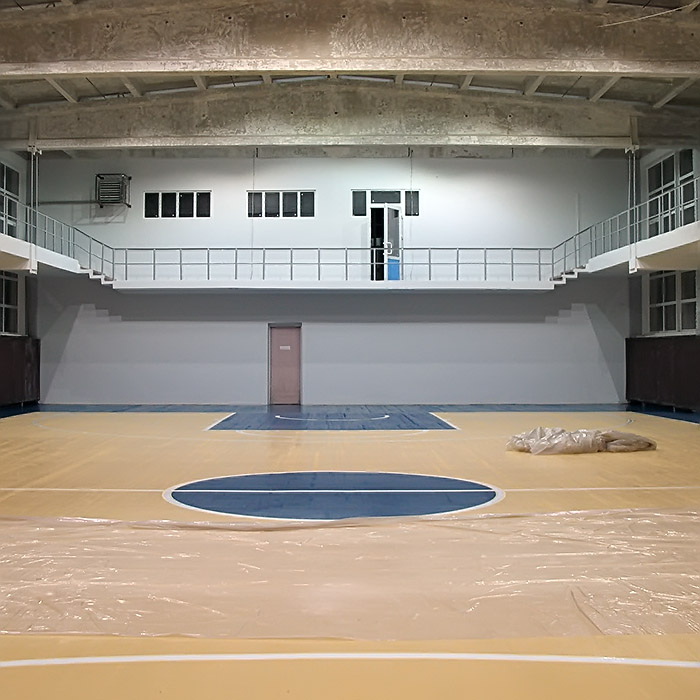

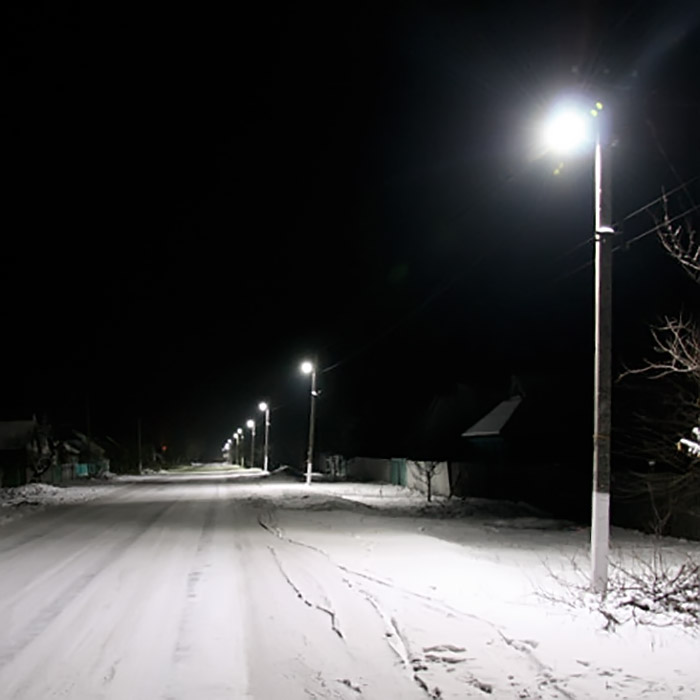
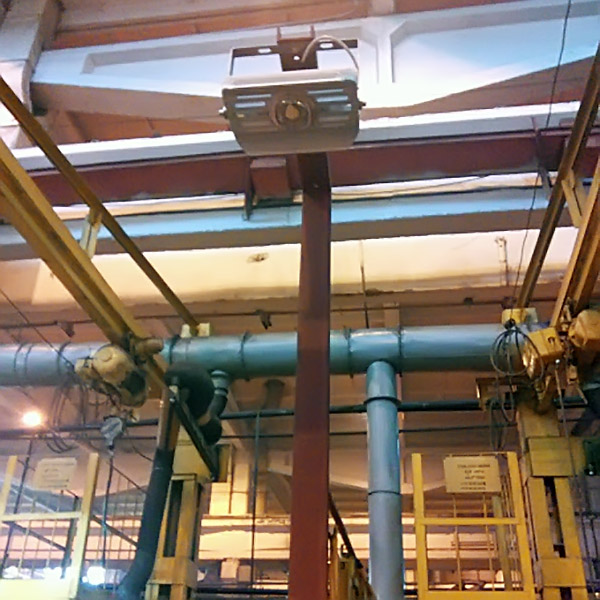
Khmelnytsky
LED LIGHTING SYSTEMS
LTU PRO UNIVERSAL LUMINAIRES FOR EXTERNAL AND INDOOR LIGHTING – it is economy, safety and reliability throughout the entire service life. The ability to change the power, color temperature and light opening angle allows us to offer solutions to problems of any complexity. The luminaires are suitable for side, top and pendant mounting on a pole, bracket, wall or cable.

| Power consumption, W | 30 – 240 |
| Luminous flux, Lm/W | 130-170 |
| Angle of light opening | 30°, 60°, 90°, 120°, 180° |
| Color temperature, K | 2700 – 6500 |
| LED Matrix (SMD, COB) | LTU Enterprise, Seoul Semiconduktor, CREEE, NICHIA etc. |
| Color rendering index | 70-80 CRI (Ra) |
| Warranty period, g | 5 |
| Operating life, g | 10 |
| Protection level | IP65, IP67 |
| Input voltage, V | 100-305, 220 |
| Working temperature, C | -40 – +50 |
| Overall dimensions, mm | 160x190x150, 270x190x150, 350x190x150 |
| Weight, kg, no more than | 7,5 |
LED MODULES FOR UV ILLUMINATORS
FLAT UV LED COB MODULE
To create prototypes of effective UV-C LED modules for combating viruses, technical solutions will be applied in accordance with the Ukrainian patent for invention №. 111099 “Multi-chip LED module”. The development is based on task of improving the multi-chip LED module of the UV-C radiation range. This problem is solved by the fact that the LED multi-chip module includes a thermally conductive base, an electrically insulating film with holes, thermally conductive electrically conductive interconnection elements, and a plurality of LED chips combined into an electrical circuit. In this case, the frame of the radiating area of the module is made of a heat-conducting electrically conductive material and consists of two separate parts mounted on an electrically insulating film. Each of which has contact pads. LED crystals are installed on a heat-conductive electrically conductive base or on heat-conductive electrically isolated interconnection elements.
At the same time, surfaces of the heat-conducting base, the frame of the radiating region and the electrically conductive interconnection elements are covered with a reflective coating with a reflection coefficient of UV radiation up to 90%-92%, and the free space in the frame of the radiating region of the module is filled with an insulating optically transparent material.
The possibility of placing each LED crystal with its back side on a heat-conductive electrically conductive base, as well as heat-conductive electrically conductive interconnection elements with reflective coatings with a high reflection coefficient of UV radiation, increases the electrical power dissipation of the LED module while maintaining the proportionality of the input-output parameters, in particular, optical power. This technical result is ensured due to the fact that the proposed technical solution allows the use of LED crystals in LED modules both with vertically located contact pads and with planar contact pads. The location of the LED crystals directly on the heat-conducting base allows you to significantly reduce the thermal resistance of the crystal-heat-conducting base in the module to values of 1.5 ºС /W – 1.95 ºС /W. At the same time, the proposed technical solution makes it possible to optimally combine LED crystals of various types into series-parallel and series electrical circuits of various configurations, taking into account the possibility of using more advanced and more efficient LED crystals, including those made from new semiconductor materials. Providing a plurality of LED chips with a flat sub-chip reflector with a total reflectance of up to 92% can improve both the optical and energy efficiency of LED modules.
This technical result is achieved through the use of a new generation material from ALANOD MIRO® with a 99.99% high-purity aluminum coating applied by vacuum deposition (PVD), which provides a specular reflection of 95% of visible light with no color distortion and interference. ALANOD MIRO® material is produced in various thicknesses from 200 microns to 1 mm or more and successfully combines high thermal conductivity, electrical conductivity, and also the reflectivity of UV radiation. Because the reflectivity of aluminum reflectors can reach, depending on the surface treatment, up to 92% for the entire UVA / UVB / UVC range, from 200 to 400 nm. While reflectors made of silver and gold in the range of 200-300 nm have reflectances from 20 to 40%.
For the manufacture of UV multichip LED modules, it is planned to use both COB – technology based on aluminum wire assembly, and COF – technology based on flexible aluminum-polyimide lacquer foil interconnection elements.
To create a prototype of a flat COB LED module with a total radiation flux power of up to 60 mW, LED crystals from LG Innotek were selected. The crystals have an emission wavelength of 275 nm, a UV radiation flux power of 10 mW (efficiency = 1.3%) and an electrical dissipation power of up to 0.75 W at an operating current of up to 100 mA and an operating voltage of up to 7.5 V.
The total electrical dissipation power in the operating mode of the developed flat module prototype will be approximately 5 W, and the total cost of a set of 6 LED chips will be $60 (market value for 2021 is $1 per mW).
The appearance of a flat multi-chip LED module with six UV LED chips and its components, as well as the layout of unpackaged chips in the module is shown in fig. 5.
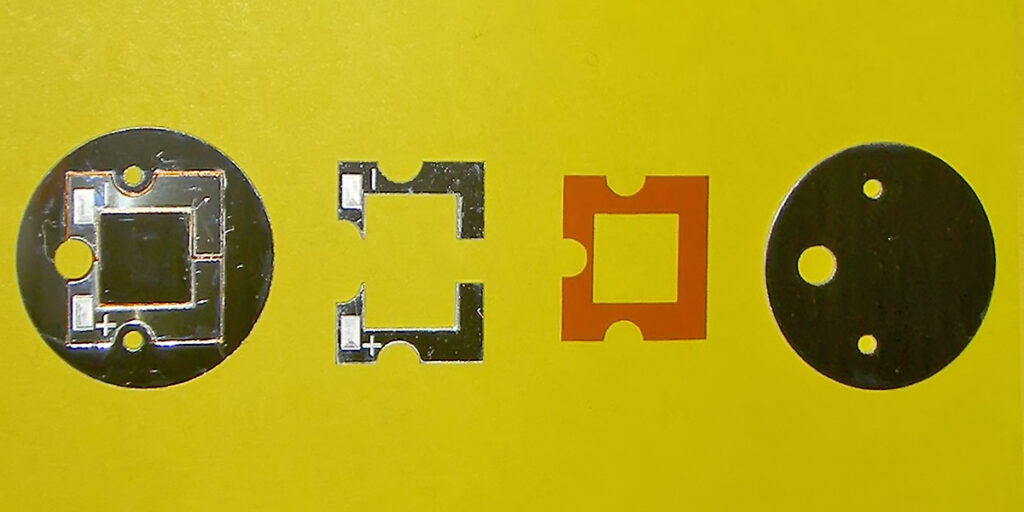
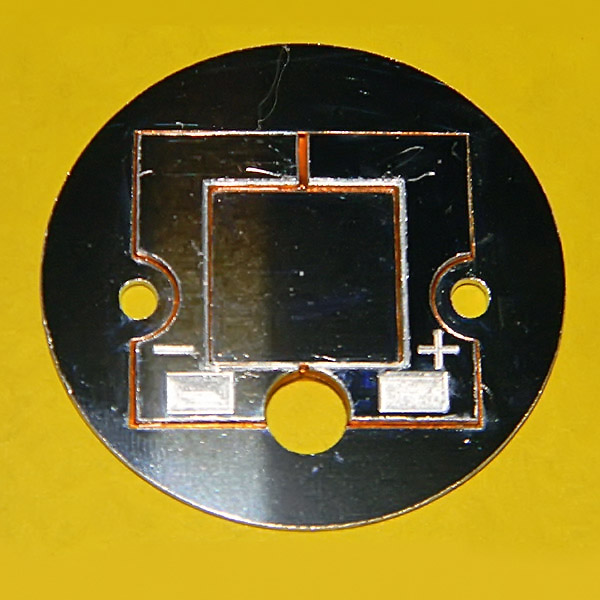
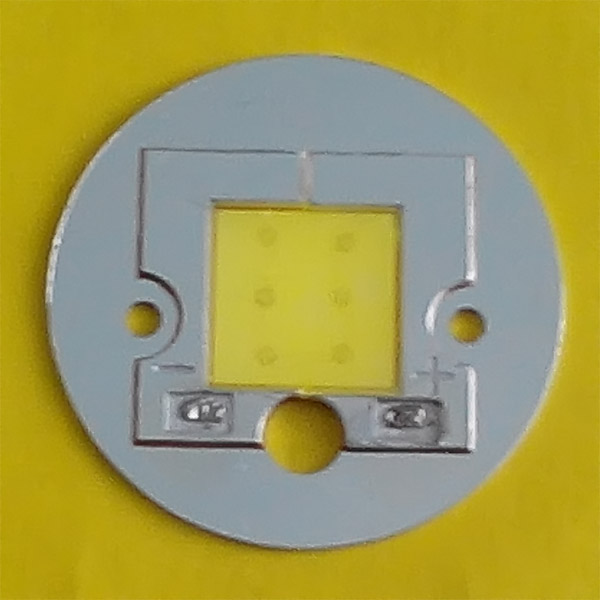
Figure 5 – Multi-chip LED module and its components:
a) module elements,
b) module assembled with LED chips,
c) module assembled with a protective coating formed from optical silicone.
Aluminum-polyimide COF assembly technology developed by LLC “RPE “LTU” made it possible to use flexible boards with flat aluminum leads 30 microns thick for interconnection crystals in UV LED modules.
Compared to the world’s widespread COB chip-on-board (chip-on-board) assembly technology, which uses aluminum or gold wire wiring and encounters significant complexity in serial-parallel connection of chips at the same level, the innovative COF assembly technology makes it possible to produce such assemblies with standard ultrasonic welding machines simply and efficiently.
On fig. 6 shows flexible board and fragment of flexible board with UV LED chips installed on it. On fig. Figure 7 shows model of high-power LED module assembled on their basis.
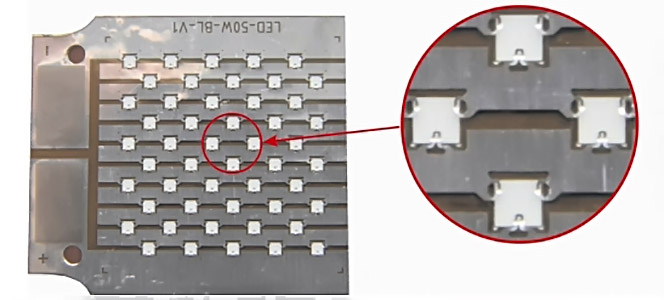
Figure 6 – Photo of flex board with LED chips installed
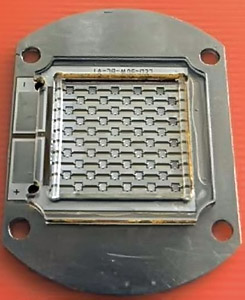
Figure 7 – Photo of layout of UV LED module
POWERFUL VOLUME UV LED MODULE
In addition to flat UV module, it is planned to develop and manufacture a prototype of the bulk LED module of the UV-C range with a wavelength of 275 nm. In this case, both proprietary flat LED COB matrix 60 mW, and purchased single-chip SMD LEDs can be used.
For example, when using SMD LEDs from LG Innotek for a prototype of a bulk module, serial LEDs with an ultraviolet radiation power of up to 50 mW, an efficiency of 1.1% and an electrical dissipation power of up to 3 W can be used (Fig. 8). More efficient SMD LEDs from the German company Laser Components can also be used, for example, S6060-IF250-W270-P110-V6.0 UV LEDs also in a 6060 type SMD package (6.0×6.0x1.3 mm) with a wavelength of 275 nm and radiation flux power up to 50 mW (efficiency = 3%) at an operating current of 250 mA and an operating voltage of 6.5 V (electric power dissipation up to 1.6 W).
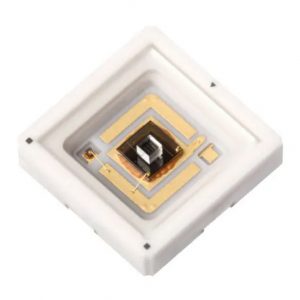
Figure 8 – SMD LED from LG Innotek in 6060 case (6.0×6.0x1.3 mm).
In 2016-2017, LLC “RPE “LTU” has already developed technical solutions for creating innovative powerful compact volumetric LED modules of white luminescence. This development was patented by LLC “RPE “LTU” in 2019 (patent of Ukraine for invention №. 120107 “Powerful lamp with a volumetric LED module”, registration date 10.10.2019).
Experience gained in creating high-power volumetric LED modules in the visible range allows us to apply already proven technical solutions according to the patent of Ukraine №. 120107 to create volumetric compact LED sources of UV-C radiation.
When using their own flat LED COB matrices with UV flux power of 60 mW and electrical power of scattering about 5 W to create a prototype of five reflector volume LED module (Fig. 6) when installed on the module radiators 10 pcs of flat LED matrices total power UV radiation flux will be about 600 mW. In this case, the electrical power of scattering of such a module will be 45-50 W.
In case of using more efficient SMD LEDs from the German company Laser Components, for example, S6060-IF250-W270-P50-V6.0 UV LEDs in a 6060 type SMD package (6.0×6.0x1.3 mm), to create a prototype of a five-dimensional reflector LED module with a wavelength of 275 nm and a radiation flux power of up to 50 mW (efficiency = 3%) at an operating current of 250 mA and an operating voltage of 6.5 V (Fig. 7) when installing 10 LEDs on the radiators of the module, the total power of the UV radiation flux will be 500 mW. At the same time, the electrical dissipation power of such a module will be about 16 W, and the total cost of a set of 10 LEDs will be $500 (the market value for 2020 is $1 per mW).
Thus, proposed technical solutions for the creation of innovative high-power UV-C emitters, including multi-chip flat LED modules and volumetric LED modules, make it possible to provide the output specific power of the ultraviolet radiation flux of modules with wavelengths of 265-275 nm at a level of 500 – 600 mW/cm2. At a distance of about 2 meters from radiation sources, the intensity of UV radiation will be 1.8-2.1 mW / cm2 or 1800 – 2100 μW / cm2, which is almost an order of magnitude higher than the limiting intensity of ultraviolet radiation (90 μW / cm2) at a wavelength of UV radiation 265-275 nm, when the process of destruction of pathogenic bacteria and viruses is already beginning.
New approaches proposed by LLC “RPE “LTU” make it possible to provide good initial competitive conditions for the formation of a scientific and technological reserve for further applied research and development in the field of creating new integrated LED sources of UV-C radiation based on semiconductor LEDs in the wavelength range from 207 to 222 nm. Which can safely reduce the concentration of coronaviruses on surfaces and airborne in crowded places, including coronavirus infection (COVID-19). And also to provide conditions for the creation and implementation in production of domestic competitive promising innovative UV-C LED technologies and compact air and surface disinfecting devices that are simple and convenient for use in everyday life, as well as their promotion on the Ukrainian and EU markets for special and domestic use ( Fig. 9, 10).
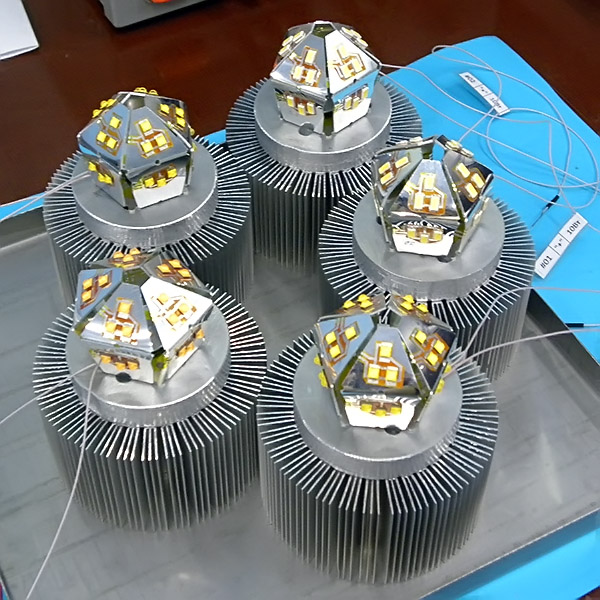
Figure 9 – Design view of model sample of volumetric disinfecting radiating device in UV-C range with radiation flux power of up to 500 mW and a radiation scattering angle of up to 320 degrees.

Figure 10 – Design view of mock-up sample of line of disinfecting UV-C radiating device with radiation flux power of up to 500 mW and radiation scattering angle of up to 150 degrees.